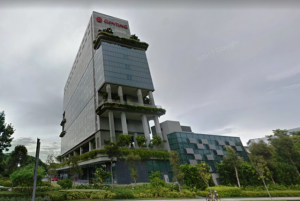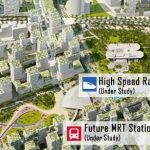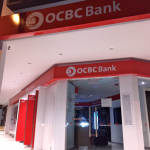Will Genting Singapore be the major victim of the the Malaysian Government’s decision to scrap the high-speed rail project between Singapore and Kuala Lumpur? The Prime Minister of Malaysia, Dr Mahathir Muhammad had yesterday in no uncertain terms confirmed that his Government will drop the High-Speed Rail (HSR) project.
“We need to do away with some of the unnecessary projects, for example the high-speed rail, which is going to cost us RM110bn (S$37bn) and will not earn us a single cent. That will be dropped,” Mahathir told the Financial Times.
“It’s not beneficial. It’s going to cost us a huge sum of money, we’ll make no money at all from this operation,” he added.
Dr Mahathir acknowledged that his Government has an agreement with Singapore and that he has to to talk with his counterparts here about dropping that project. Singapore’s Transport Ministry said that it has not received official notification from Malaysia about its decision on the HSR.
The decision by the Malaysian Government is expected to have a huge negative impact on Genting Hotel Jurong, a facility built by Genting Singapore Plc to support its operations at casino venue Resorts World Sentosa.
Table of Contents
Genting Singapore had the first-phase opening in April 2015, more than 2 years before the official signing of the Memorandum of Understanding for the HSR project. When the hotel first opened, several commentators questioned the decision to build the 557-room hotel so far from its resort in Sentosa and to bring those guests in by bus. Their questions were answered when Singapore and Malaysia inked the bilateral agreement for the HSR project on 13 December 2016.
An analyst at Maybank IB Holdings however, has poo-pooed suggestions that Genting Singapore will suffer as a result of the Malaysian Government’s decision to pull back from the project.
Maybank analyst Samuel Yin Shao Yang said that he was “not overly concerned that it (Genting Hotel Jurong) will be a white elephant.”
He said: “Genting Hotel Jurong is located in between the second link bridge [to Malaysia] and Resorts World Sentosa. Many tour buses from Malaysia would pass Genting Hotel Jurong anyway. In short, I think the hotel will still be viable in the long run.”
Genting Group’s 2017 Annual Report listed a subsidiary of Maybank (Maybank Nominees (Tempatan) Sdn Bhd) as being among its ‘thirty largest security account holders as per record of depositors as at 14 March 2018’.
The Genting Group is implicated in ongoing international investigations into 1MDB, which has been described as “the world’s largest-ever financial swindles”. The Wall Street Journal described the links between 1MDB and Genting Group as such:
“Since Mr. Najib was forced out of office in an election upset, succeeded by veteran premier Mahathir Mohamad, the extent of the alleged theft from 1MDB has faced renewed scrutiny. If Mr. Mahathir follows through on election promises to fully investigate the scandal, he will need to step into some of Malaysia’s most important boardrooms.
Among the companies exemplifying the links to 1MDB are two large conglomerates, Tanjong PLC and Genting Group . According to a person familiar with the fund’s interactions and an examination of public documents, they enjoyed a quid-pro-quo relationship with 1MDB and Mr. Najib’s political dynasty.”
It is hard to imagine how Genting Hotel Jurong and Genting Singapore will not suffer from the pullout of the HSR considering that it is but a stone-throw away from the canned project (perhaps built with the sole idea of benefiting from the project) and the lack of human traffic without the project.
Besides the unpredictable fortunes of Genting Hotel Jurong, those that have bought properties in the area (or are looking to buy one there soon), need not be overly concerned that prices of their properties will plummet when the plug is officially pulled from the HSR project.
International Property Advisor’s chief executive officer, Mr Ku Swee Yong, noted that “Those who bought property in the Jurong area with the purpose of investment would be disappointed as their investments might only bear them good gains many years later,” and that “Developers will be a lot more careful and less aggressive with their bid price going forward.”
But even without the HSR project and with the exception of Genting Singapore, the development in the area will prosper as it is hinged on the Singapore Government’s blueprint for the Jurong Lake District, which was first unveiled in the 2008 Master Plan when the area was earmarked as a new growth area.
There is now some 160 hectares of land that is yet to be developed within the 360-hectare district. More than 40 per cent of the mixed-use business area is set aside for residential purposes. Developments for the Jurong Lake District are centered around the Jurong East MRT station. With established businesses around the MRT station – like the International business park, IMM (a major shopping mall), along with other new shopping malls, a hospital, educational hubs, high rise offices and residential units – Jurong Lake District is looking very credible as a regional centre even without the HSR project.

According to the URA’s Masterplan, most of the developments will be centred around Jurong Gateway for a start. Jurong Gateway is also most likely to be the crown jewel in the Jurong Lake District vicinity. With a catchment consumer base of Jurong East HDB dwellers and the Lakeside village (a designated dining place) the Jurong Lake District is likely to be developed fast and find success quickly. Good tenants at Lakeside village may bring people closer to enjoying the lakeside. Lakeside village is connected via bridges to Japanese Garden and Chinese Garden, bringing lakeside enjoyment to the residents staying nearby.
Projects along Yuan Ching Road are yet to be developed, but once this area develops with waterfront hotels, it would revitalize the area and possibly lead the Jurong Lake District to become a reality much sooner – in 5 – 7 years time. Some HDB flats around Ho Ching road area in the Jurong Lake District are built in 1972 and are ripe for selective en-bloc redevelopment, at 42 years old.
Besides, the stakeholders in the western part of Singapore are also expected to get a boost from the announcement of the seventh MRT line – the Jurong Region Line. The new line will serve the Jurong area and the western part of Singapore and is expected to lift the fortunes of not just the properties in the Jurong Lake District area, but also the real estate in Boon Lay and Choa Chu Kang.
The Jurong Region Line will be 24km long with 24 stations, and will run above-ground. It will open in three phases, starting from 2026. The Jurong Region Line will give commuters route choices. For example, the two interchange stations at Choa Chu Kang and Boon Lay will connect the North-South Line (NSL) and East-West Line (EWL), giving commuters alternative travel routes.
So what’s driving the interest in the Jurong Lake District area is not the HSR project, but the successful transformation resulting from the Jurong Gateway initiative. The HSR project, if it takes off, will only be a nice bonus to the buyers of property in that area.
—
If you are home-hunting in the Jurong Lake District area, our Panel of Property agents and the mortgage consultants at icompareloan.com can help you with affordability assessment and a promotional home loan. The services of our mortgage loan experts are free. Our analysis will give best home loan seekers better ease of mind on interest rate volatility and repayments.
Just email our chief mortgage consultant, Paul Ho, with your name, email and phone number at paul@icompareloan.com for a free assessment.






